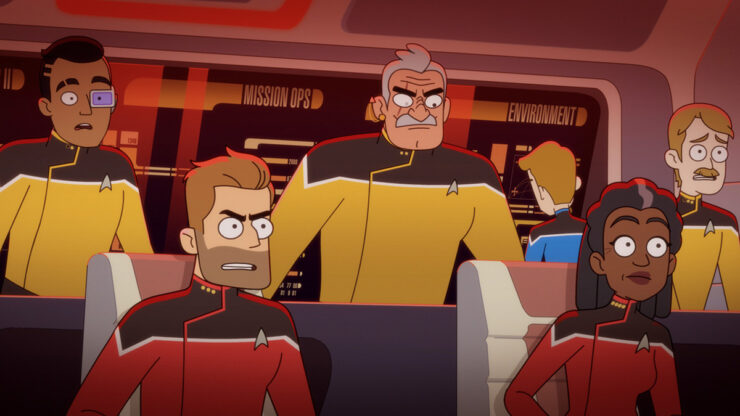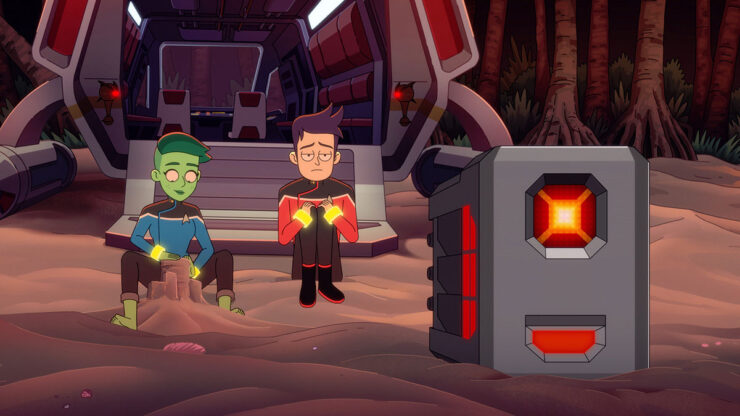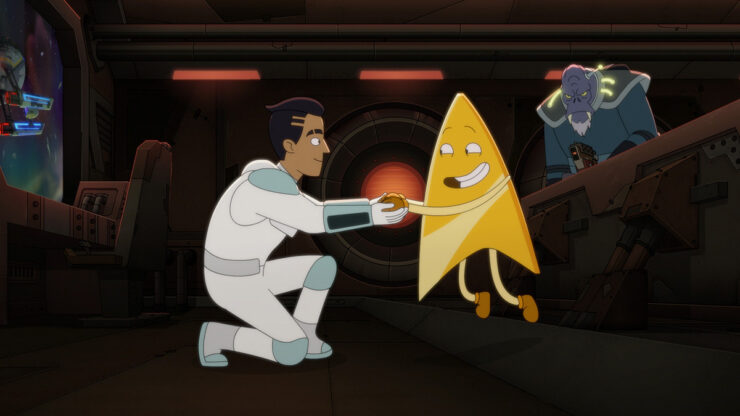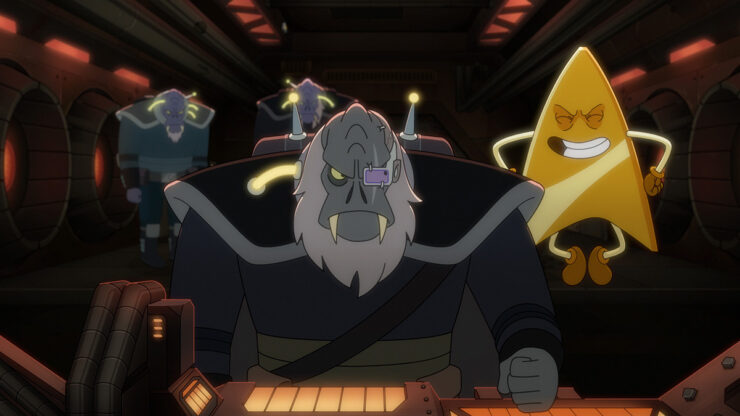In almost every episode so far of this season of Lower Decks, we’ve seen a strange little ship that has shown up and seemingly blown a vessel to bits: Ferengi, Romulan, Klingon, etc., and this week we not only see the ship go after a Bynar vessel, but we find out who’s behind it all.
My own theory, posed during my review of “Twovix” and “I Have No Bones Yet I Must Flee,” has been that it’s AGIMUS and Peanut Hamper having merged and wreaking havoc. Was I right? Let’s find out…
Amusingly, the episode in which the culprit was revealed is also an episode that prominently features the return of both AGIMUS (voiced by the great Jeffrey Combs) and Peanut Hamper (voiced by the equally great Kether Donohue). But it’s not them—it’s Badgey!
Harken back to the third-season finale, “The Stars at Night,” which had a post-credits scene that shows the device hosting Badgey being tractored into a ship. Turns out it was a Drookmani ship, and Badgey didn’t waste a nanosecond in taking over the vessel. Since then, he’s been bopping around the quadrant hitting ships.
The Bynar ship being targeted, though, was for a very specific reason: it happened to be in a location proximate to the Cerritos, because the psychotic AI has some unfinished business with his “father,” Rutherford.
Sure enough, Starfleet sends the Cerritos due to that proximity, but neither Tendi nor Boimler are going with, as they have other business back on Earth at the Daystrom Institute. Peanut Hamper has been a model citizen and is up for parole, and Tendi’s presence has been requested at the parole hearing. Meanwhile AGIMUS claims to have information about the attack on the Bynar ship, but will only share this information with Boimler, whom he views as his nemesis.

The Badgey portion of this plot manages to hit several Trek clichés, notably two tropes from the original series, to wit, the splitting of a being into “good” and “evil” components (“The Enemy Within”), as well as somehow talking an artificial intelligence into imploding (“The Changeling,” “I, Mudd,” “Return of the Archons,” etc.).
It starts with Rutherford pulling a Data-in-Nemesis and doing a space walk to put himself into Badgey’s clutches in the hopes that he’ll spare the Cerritos. Mariner goes along because Tawny Newsome is the first listed in the opening credits and she needed something to do. (Having said that, just barreling along to join Rutherford is pretty on-brand for Mariner, but she really doesn’t serve any purpose at any point in the episode.)
First, Rutherford tries to appeal to Badgey’s good side, but that just results in the split into good and evil—or, rather good and bad, as the bad part is still called Badgey, but the good part is called, I kid you not, Goodgey. I suppose they couldn’t resist.
Buy the Book


System Collapse
Then he tries to appeal to logic, but that just results in another split into a third being: Logicey. (Despite how it’s spelled, it’s pronounced with a hard C. Maybe it should be “Logickey”? No, then it sounds like it’s the key to logic…)
So we go from “The Enemy Within” to Farscape’s “My Three Crichtons,” as there are now three Badgeys competing for dominance, and each split makes Badgey that much more evil, as he’s functioning without good and without logic.
Which only leaves Rutherford with one solution, and it’s a very Trek one, one that we’ve also seen before, most recently in Picard’s “Surrender”: he gives Badgey love. He hugs him and shows compassion and gives love and forgives him his sins, and it’s a lovely moment.
And it doesn’t entirely work, because Badgey’s goodness is in Goodgey and his logic is in Logicey, and now he’s going to upload himself to every single computer in the Federation and then he’ll take over the world! Um, that is, galaxy!
Except that level of awareness of the universe brings enlightenment and yet another Trek standby, ascension to a higher plane of existence (which we’ve already seen in “Moist Vessel,” and which was also seen versions of in the original series’ “Errand of Mercy,” TNG’s “Transfigurations,” and Voyager’s “The Gift”). Badgey becomes a higher being of pure energy, thus sparing the Federation computers from his infiltration.
Meanwhile, we see AGIMUS in group therapy for psychotic AIs, which, um, looks just like a twenty-first-century group session, complete with folding chairs in a circle, and goodness gracious, can’t we show a little imagination? I mean, okay, it’s part of the joke that it’s just like a group session that’s familiar to the audience, but with evil computers. But still…

AGIMUS and Peanut Hamper are also working together in the prison garden, a scene that I swear makes me think of a tableau in Arkham Asylum with Harley Quinn and Poison Ivy. Which is fine! That made it funnier! Anyhow, the two are plotting evilly. AGIMUS has switched his menacing red-orange light into a sky-blue one in order to fool people into thinking he’s good and compassionate now. Meanwhile, Peanut Hamper has been practicing her fake speech for the parole board. AGIMUS has an escape plan, and once she’s on parole and he’s freed himself, they’re going to meet up and find a planet to take over.
At first, the plan goes swimmingly. AGIMUS convinces Boimler to take him to some drones he left behind, as they’ve recorded what happened to the Bynar ship. Meantime, Tendi waxes rhapsodic about how heartfelt Peanut Hamper’s speech was to the parole board, and they granted it. Tendi and Boimler take AGIMUS in their shuttle, but the AI manages to take over the shuttle and imprison the two lieutenants.
But when they arrive at the rendezvous, AGIMUS is disheartened to learn that Peanut Hamper isn’t there. At first, he cackles madly, proud of the fact that she double-crossed him like a true creature of evil. However, it soon becomes clear that without her, AGIMUS’s heart isn’t really in it. He tries taking over a planet, which he does in nothing flat, but it brings no joy for him. Instead, he seeks out Peanut Hamper, and finds her reunited with her Exocomp family.
Turns out that Peanut Hamper’s fake speech wasn’t as fake as she’d intended, as she realized while giving it to the parole board that every word was true. (This has the fortuitous side effect of making Tendi not look so bad. When she carried on about how great Peanut Hamper’s speech was, you think Tendi’s a fool for falling for Peanut Hamper’s nonsense, but it turns out that Tendi saw the sincerity that Peanut Hamper herself didn’t expect.) She’d rather be at home with her family than out conquering worlds with AGIMUS. For his part, AGIMUS was only really interested in going out to conquer worlds again because he was going to be doing it with his friend. Doing it alone was empty.
Thus we once again have a wonderfully Trekkish solution to the problem. The friendship that developed between AGIMUS and Peanut Hamper has been good for both of them, and led them down a road of compassion. The bit at the end when Peanut Hamper introduces AGIMUS to her parents is adorable. And then, of course, Boimler and Tendi have to take AGIMUS back to the Daystrom Institute.
As you may have gathered, the DNA of lots of other Trek productions are present in this episode (as well as from a few other sources). I didn’t even mention all of them—for example, AGIMUS noticing Boimler’s promotion to lieutenant junior-grade is very reminiscent of Khan’s learning that Kirk has been promoted to admiral in The Wrath of Khan (one of the best things about Ricardo Montalban’s performance in that movie is the way he sneers the word “admiral” throughout the film). But that’s not a critique! It takes all those familiar tropes and weaves them together into a very entertaining episode. We get three of the show’s best creations in the three evil AIs all not only returning, but finding some measure of redemption. It helps that Combs, Donohue, and Jack McBrayer (as the various Badgeys) do fantastic voice work. Combs is especially fabulous (as usual), showing AGIMUS’s conflict between good and evil (the same conflict is writ more literal with Badgey, of course). And I especially like that, after “A Mathematically Perfect Redemption,” we’re primed for Peanut Hamper to go back to being a selfish shit, so it’s nice to see that this redemption actually took, unlike the fake one in the third-season episode.
This is exactly the kind of story LD does best: a humorous take on Trek, but one that still lives up to its ideals and themes. There’s still some twenty-first-century life stuff unconvincingly brought forward to the Trek universe (parole hearings, the group session), but I can live with that when the rest of the episode is as entertaining as this.

Random Thoughts
- Badgey was introduced in “Terminal Provocations,” and returned to enact revenge on Rutherford in “No Small Parts.” AGIMUS was introduced in “Where Pleasant Fountains Lie.” Peanut Hamper was introduced in “No Small Parts,” and returned in “A Mathematically Perfect Redemption,” at the end of which she met AGIMUS and their beautiful friendship was begun.
- We do find out that the ships weren’t completely vaporized, but instead broken into bits for the Drookmani and Badgey to salvage. What isn’t at all clear (and which I hope will be made so in a future episode) is what happened to the crews. Given that the ships were still broken up, they’re probably dead, but maybe not? As I said, it’s not at all clear, and I hope there’s some clarity on that soon, as that’s a lot of death…
- The title is a riff on the Western movie For a Few Dollars More, the sequel to A Fistful of Dollars. Amusingly, TNG did a title riff on the earlier film, “A Fistful of Datas,” which was also about an AI that propagated, in that case with multiple images of Data on the holodeck.
- Another one of the evil AIs in the group session is named Lord Tyranokillicus, which is, simply put, the best name ever. Bravo.
- At the beginning and end of the episode, Rutherford is experimenting with putting an old-fashioned grappler (like the ones used on the NX-01 on Enterprise, which took place before Earth developed tractor beams) on a shuttlecraft. Alas, it isn’t as precise as one might like, first ripping off Tendi’s uniform top, then leaving Boimler hanging upside down from the bulkhead.
- At the end, while Logicey is horribly murdered by Badgey, Goodgey remains, with Rutherford insisting that he won’t turn evil. The other three are not entirely convinced of this…
- Bynars were introduced in the TNG episode “11001001.” This marks only their second appearance onscreen, though the society was seen in more depth in the Starfleet Corps of Engineers series of novellas that ran from 2000-2007 (which was edited by your humble reviewer). One of the main characters was a Bynar whose bondmate died, but who chose to remain a “singleton,” which ostracized him from mainstream Bynar society. Bynaus was explored in the novella 10 is Better Than 01 by Heather Jarman.
- As Badgey ascends, we get to see the koala again! The koala has already been mentioned as part of ascension in “Moist Vessel,” and seen by people having near-death experiences, including Boimler (in both “First First Contact” and “In the Cradle of Vexilon”) and Stevens (“Mining the Mind’s Mines”). It was also visible in the animated opening credits of SNW’s “Those Old Scientists.” At this point, I think the koala should start showing up in every Trek show, just to keep the gag going…
Keith R.A. DeCandido’s latest work is “Prezzo,” a new story that appears in Weird Tales: 100 Years of Weird, an anthology celebrating the centennial of Weird Tales magazine, edited by Jonathan Maberry. The anthology, which is on sale now in hardcover, eBook, and audio, includes new stories by Scott Sigler, Laurell K. Hamilton, R.L. Stine, James Aquilone, Hailey Piper, Blake Northcott, and Dana Fredsti; new poetry by Linda D. Addison, Owl Goingback, Marge Simon, Jessica McHugh, Anne Walsh Miller, and Michael A. Arnzen; essays by Lisa Morton, Lisa Diane Kastner, Charles R. Rutledge, James A. Moore, Henry L. Herz, and Jacopo della Quercia & Christopher Neumann; and reprints of classic stories by H.P. Lovecraft, Robert E. Howard, C.L. Moore, Richard Matheson, Ray Bradbury, Isaac Asimov & Frederik Pohl, Victor LaValle, Usman Malik, Karin Tidbeck, Allison V. Harding, and Tennessee Williams.










